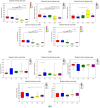Risk of Secondary Bacterial Infections Revealed by Changes in Trachinotus ovatus Skin and Gill Microbiota During a Cryptocaryon irritans Infection Cycle
- PMID: 40732169
- PMCID: PMC12298295
- DOI: 10.3390/microorganisms13071660
Risk of Secondary Bacterial Infections Revealed by Changes in Trachinotus ovatus Skin and Gill Microbiota During a Cryptocaryon irritans Infection Cycle
Abstract
This study aims to investigate the response of surface bacterial communities in Trachinotus ovatus to Cryptocaryon irritans infection at different stages of a single infection cycle (0~168 h). These samples were analyzed using high-throughput 16S rRNA sequencing. Alpha diversity analysis showed a reduction in the richness and diversity of skin microbiota during infection, with partial recovery post-detachment. Beta diversity analysis revealed distinct structural shifts in skin microbiota at early (24 h) and post-detachment (168 h) stages compared to other phases, while gill microbiota remained stable except during detachment. At the phylum level, Proteobacteria, Actinobacteriota, Bacteroidetes, and Firmicutes were dominant on the skin at different stages, whereas the gill microbiota was predominantly Proteobacteria (>90%). At the genus level, opportunistic pathogens, such as Vibrio and Nautella, increased in relative abundance on the skin with the infection progression, while gill microbiota composition barely changed. The hepatic bacterial load continued to increase with infection duration. These findings indicate that C. irritans alters microbiota composition on skin, facilitating pathogen invasion, thereby elevating the risk of secondary bacterial infections in T. ovatus.
Keywords: Cryptocaryon irritans; Trachinotus ovatus; microbiota; safety; secondary bacterial infections; skin and gill.
Conflict of interest statement
The authors declare no conflicts of interest.
Figures








Similar articles
-
Stage of pregnancy impacts the bacterial communities of reproductive and placental tissues in gilts.J Anim Sci. 2025 Jan 4;103:skaf159. doi: 10.1093/jas/skaf159. J Anim Sci. 2025. PMID: 40336167
-
Diversity and Composition of Gut Microbiota in Different Developmental Stages of the Tibetan Toad (Bufo tibetanus).Animals (Basel). 2025 Jun 12;15(12):1742. doi: 10.3390/ani15121742. Animals (Basel). 2025. PMID: 40564294 Free PMC article.
-
Role of immunoglobulin M in Trachinotus ovatus defense against Cryptocaryon irritans infection.Int J Biol Macromol. 2025 Aug;319(Pt 2):145556. doi: 10.1016/j.ijbiomac.2025.145556. Epub 2025 Jun 25. Int J Biol Macromol. 2025. PMID: 40578639
-
Gut Microbiota Composition in Prediabetes and Newly Diagnosed Type 2 Diabetes: A Systematic Review of Observational Studies.Front Cell Infect Microbiol. 2022 Aug 15;12:943427. doi: 10.3389/fcimb.2022.943427. eCollection 2022. Front Cell Infect Microbiol. 2022. PMID: 36046745 Free PMC article.
-
Antiretrovirals for reducing the risk of mother-to-child transmission of HIV infection.Cochrane Database Syst Rev. 2011 Jul 6;(7):CD003510. doi: 10.1002/14651858.CD003510.pub3. Cochrane Database Syst Rev. 2011. PMID: 21735394
References
-
- Tan X., Sun Z., Huang Z., Zhou C., Lin H., Tan L., Xun P., Huang Q. Effects of dietary hawthorn extract on growth performance, immune responses, growth- and immune-related genes expression of juvenile golden pompano (Trachinotus ovatus) and its susceptibility to Vibrio harveyi infection. Fish Shellfish Immunol. 2017;70:656–664. doi: 10.1016/j.fsi.2017.09.041. - DOI - PubMed
-
- Zhao W., Fang H.H., Gao B.Y., Dai C.M., Liu Z.Z., Zhang C.W., Niu J. Dietary Tribonema sp. supplementation increased growth performance, antioxidant capacity, immunity and improved hepatic health in golden pompano (Trachinotus ovatus) Aquaculture. 2020;529:735667. doi: 10.1016/j.aquaculture.2020.735667. - DOI
-
- Chen F., Liang W., Chen M. Histopathological study on Cryptocaryon irritans infection in Trachinotus ovatus. Fish. Res. 2017;39:181–187.
-
- Su Y. Investigation and prevention and control strategies of Cryptocaryon irritans infection in marine cage-cultured fish in major mariculture areas of Fujian Province. J. Fish. Sci. Technol. Inf. 2009;36:4–7.
-
- Diggles B.K., Adlard R.D. Taxonomic affinities of Cryptocaryon irritans and Ichthyophthirius multifiliis inferred from ribosomal RNA sequence data. Dis. Aquat. Org. 1995;22:39–43. doi: 10.3354/dao022039. - DOI
LinkOut - more resources
Full Text Sources

